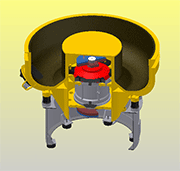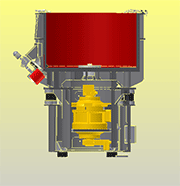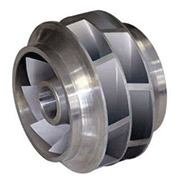E-Archive
Articles
in Vol. 20 - March Issue - Year 2019
Rotary Vibrators Without Center Dome Open Up New Finishing Possibilities

Picture 1: Standard rotary vibrator with vibratory motor located in the center dome

Picture 2: DL rotary vibrator with vibratory motor located below the processing bowl

Picture 3: DL rotary vibrator with two vibratory motors placed outside of the processing bowl


… Aerospace (blisks, turbine disks, guide vanes, turbine blades,…)


… Automotive (wheels, turbocharger impellers, gears,…)


…Forge, foundry & steel industry (forging molds, drawing molds, pump impellers,…) …and many more!

DL vibrator with semi-automatic handling of the processing media
When mass finishing was “invented” in the 1950’s, it was truly a sensation with a huge impact on many metal-processing industries. It represented not only a major step away from manual deburring and surface grinding towards mechanical surface finishing. But it also proved very strikingly that mechanical surface finishing dramatically reduced the finishing costs with, at the same time, much better and much more consistent finishing results. With such obvious cost and technical advantages, it is not surprising that in the 1950’s, large international automobile companies like Volkswagen, Mercedes Benz, etc. patiently waited more than three years for the delivery of a simple tub or rotary vibrator.
Since that time, mass finishing has been constantly re-inventing itself and has evolved into a highly specialized technology for deburring/edge radiusing, surface smoothing or high gloss polishing of not only metal but also plastic, wood and ceramic components in a wide range of industries. Along the way, completely new equipment concepts like drag finishers, surf finishers, plunge finishers, extra-large tub vibrators, etc., were developed. A more recent development is rotary vibrators without a center dome allowing the precise mechanical finishing of the most complex work pieces.
A small design change - with big effects!
Rotary vibrators are by far the most commonly used mass-finishing machines. Around the world, there are tens of thousands of units operating in such diverse industries as automotive, aerospace, jewelry, dental and orthopedic implants, small gun ammunitions, etc. They are usually equipped with a vibratory motor located in the center dome of the processing bowl with the work pieces tumbling loosely in the processing media (picture 1). Standard rotary vibrators are excellent for processing large volumes of relatively small, non-delicate work pieces.
By simply placing the vibratory drive system below the processing bowl (picture 2), respectively to the outside (picture 3), i.e. eliminating the center dome, completely new finishing possibilities could be created for complex work pieces of all sizes, from very small to very large, which to-date had to be finished by hand.
New design concept offers tangible technical benefits
Either one large or multiple small parts are firmly attached to the bottom of the processing bowl resulting in significant technical benefits:
The pressure between the media and work pieces is much higher producing a 30% higher process intensity
The media is equally effective on external as well as internal, difficult-to-reach surface areas
The media will not lodge in the work pieces
Since the parts are firmly fixed and cannot touch each other during the process, no nicking or scratching takes place
Very delicate, filigreed contours are always maintained
The higher processing intensity allows for using smaller media creating very fine surfaces
Equally effective on small parts and large components weighing up to 2 tons
Elimination of the center dome allows the processing of multiple small parts or one large component. There are DL vibrators that can handle work pieces with diameters of up to 1,600 mm and weighing more than 2,000 kg!
Some examples
The task: Finishing of bi-mobile acetabular cups for hip joint
The concave area of the cups must be extremely smooth, because it contains a movable PE head to allow greater hip movement.
The solution: DL rotary vibrator with special work piece fixture in the bottom of the processing bowl
The 2-stage process achieves an Rz value of 0.1 μm on the concave area of the cup!
The task: Smoothing of steam channels in fan hub frame for jet engine (OD = 1,700 mm)
The steam channels must be smoothed down from Ra = 3.2 to 1.6 μm.
The solution: Extra-large DL rotary vibrator with special work piece fixture holding one work piece at a time
The required Ra values are achieved within a processing time of less than 10h!
No more manual finishing of complex, delicate work pieces!
DL rotary vibrators without a center dome opened up completely new possibilities for mechanically finishing a wide range of small and large components, which to-date had to be finished by hand.
This not only eliminated the shortcomings of manual operations but ensured consistent, absolutely repeatable finishing results for work pieces from such diverse industries as….
Simplified work piece handling by partial automation
Partial automation of the DL vibrators greatly facilitates the handling of the work pieces and the processing media!
For example,
The machines can be equipped with electro-magnetic clamping devices for easy fixturing of the work pieces in the bottom of the processing bowl.
Or, the processing media can be automatically discharged from the processing bowl for easy removal of the finished part and placement of new, raw work pieces in the machine
Or, the processing media can be classified for the discharge of undersize media from the system, thus maintaining the efficiency of the finishing process.
The simple elimination of the center dome in conventional rotary vibrators opened up completely new mechanical finishing possibilities for complex components, which to-date had to be finished by costly, fairly unreliable manual deburring, grinding and polishing operations. In numerous applications, these innovative DL vibrators have been shown to produce superior finishing results at a fraction of the cost of the manual finishing operations they replaced!
For Information:
Rösler Oberflächentechnik GmbH
Vorstadt 1, 96190 Untermerzbach
Germany
Tel. +49.9533.924-0
Fax +49.9533.924-300
E-mail: info@rosler.com
www.rosler.com



























